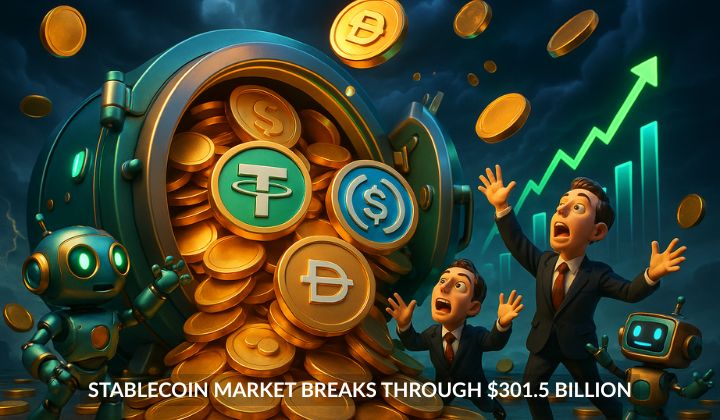Something interesting happened last week that most people probably missed while watching Bitcoin’s wild price swings. The total stablecoin supply quietly smashed through $301.5 billion, hitting an all-time high right after crypto markets had one of their worst days this year.
Think about that timing for a second. Just days after President Trump announced 100% tariffs on Chinese imports and triggered a market meltdown that wiped out $500 billion in crypto value, investors were still moving money into dollar-pegged digital assets. That tells you something important about where this market is heading.
Since January, we’ve seen nearly $100 billion in fresh stablecoin creation. That’s not a small change — it’s a 50% jump that shows real institutional money flowing into crypto infrastructure, even when everyone’s talking about volatility and crashes.
Why Smart Money Chose Stablecoins Over Exits
Here’s what caught my attention: when markets crashed on October 10th, investors didn’t run for traditional banks. They moved money into Tether and USDC instead. That’s a fundamental shift in how people think about financial safe havens during market stress.
Tether still dominates with around $180 billion in circulation, while USDC holds about $75 billion. But the real story is happening with newer players. Ethena’s USDe has grown to $12 billion and grabbed the third-place spot, showing that innovation in stablecoins is attracting serious capital.
This isn’t retail speculation driving growth anymore. Major payment processors like Visa and PayPal now support stablecoin transactions. Traditional finance companies are using them for settlements. JPMorgan analysts recently projected that stablecoin adoption could generate an additional $1.4 trillion in U.S. dollar demand by 2027. When Wall Street starts throwing around numbers like that, you know something real is happening.
The Trading Numbers Tell the Real Story
Supply growth is impressive, but trading activity reveals what’s actually going on. Total stablecoin trading volume hit $10.3 trillion in Q3 2025 — the busiest quarter since the peak of the last bull run. Daily volumes averaged $124 billion, which means these assets aren’t just sitting in wallets collecting dust.
What’s fascinating is how market share is shifting. Tether expanded its dominance from 77% to 82% during this period, while USDC’s share slipped from 14% to 10%. Even more interesting: USDT finally overtook USDC in decentralized exchange volume, crossing $100 billion in monthly DEX trading for the first time.
What This Actually Means
Rising stablecoin supply has historically preceded bullish market cycles. These assets serve as “dry powder” for investors waiting to buy other cryptocurrencies when conditions improve. Having $301.5 billion sitting ready suggests significant capital is prepared to flow into markets when the timing feels right.
But there’s something bigger happening here. Instead of completely exiting crypto during volatile periods, investors are choosing regulated stablecoins as temporary parking spots. That’s institutional-grade risk management becoming standard practice across the industry.
The $301.5 billion milestone represents more than market speculation. It’s evidence that digital assets are becoming permanent fixtures in global finance, with stablecoins serving as the essential bridge between traditional banking and crypto markets. That bridge just got a lot stronger.
You need to login in order to Like

















Leave a comment